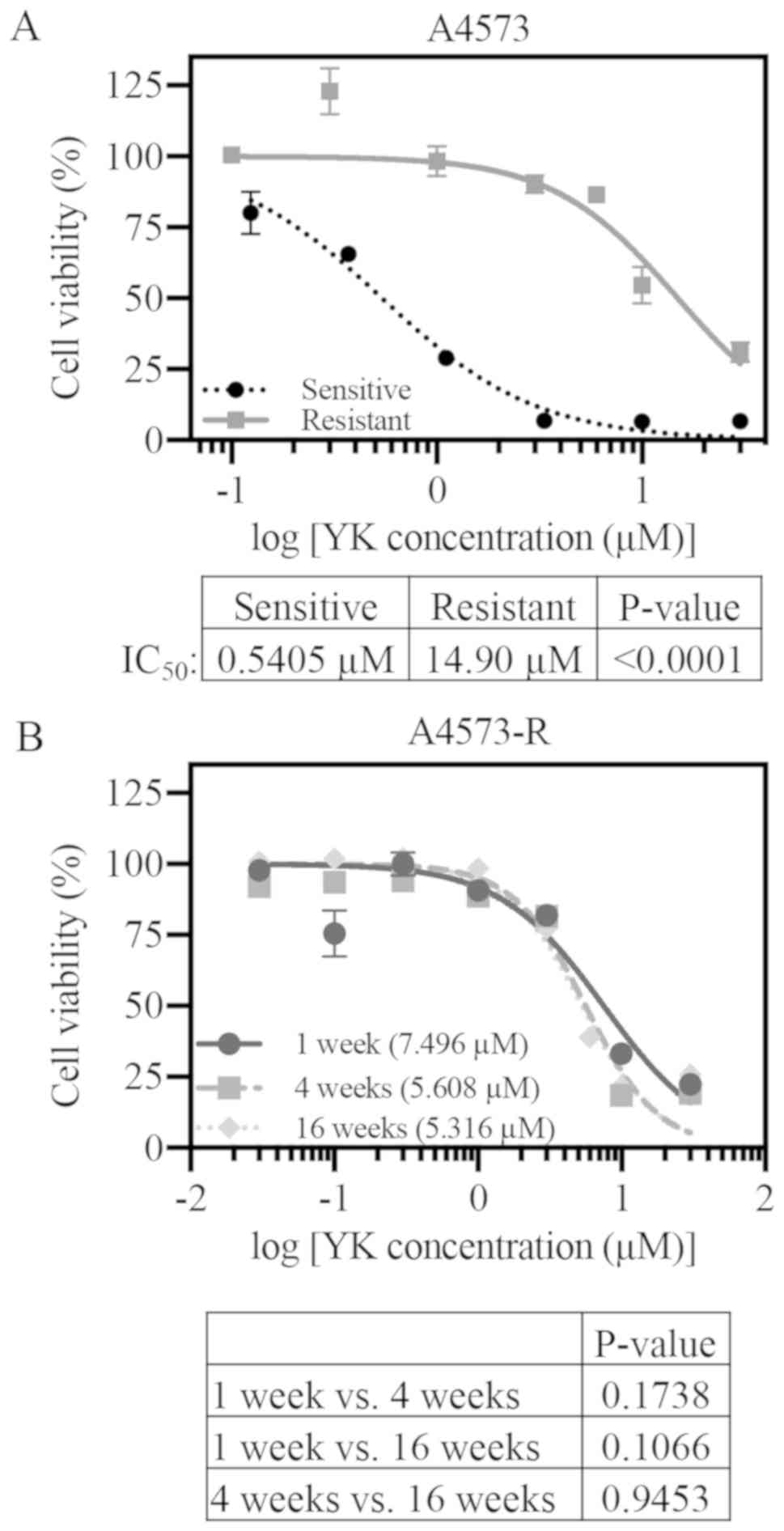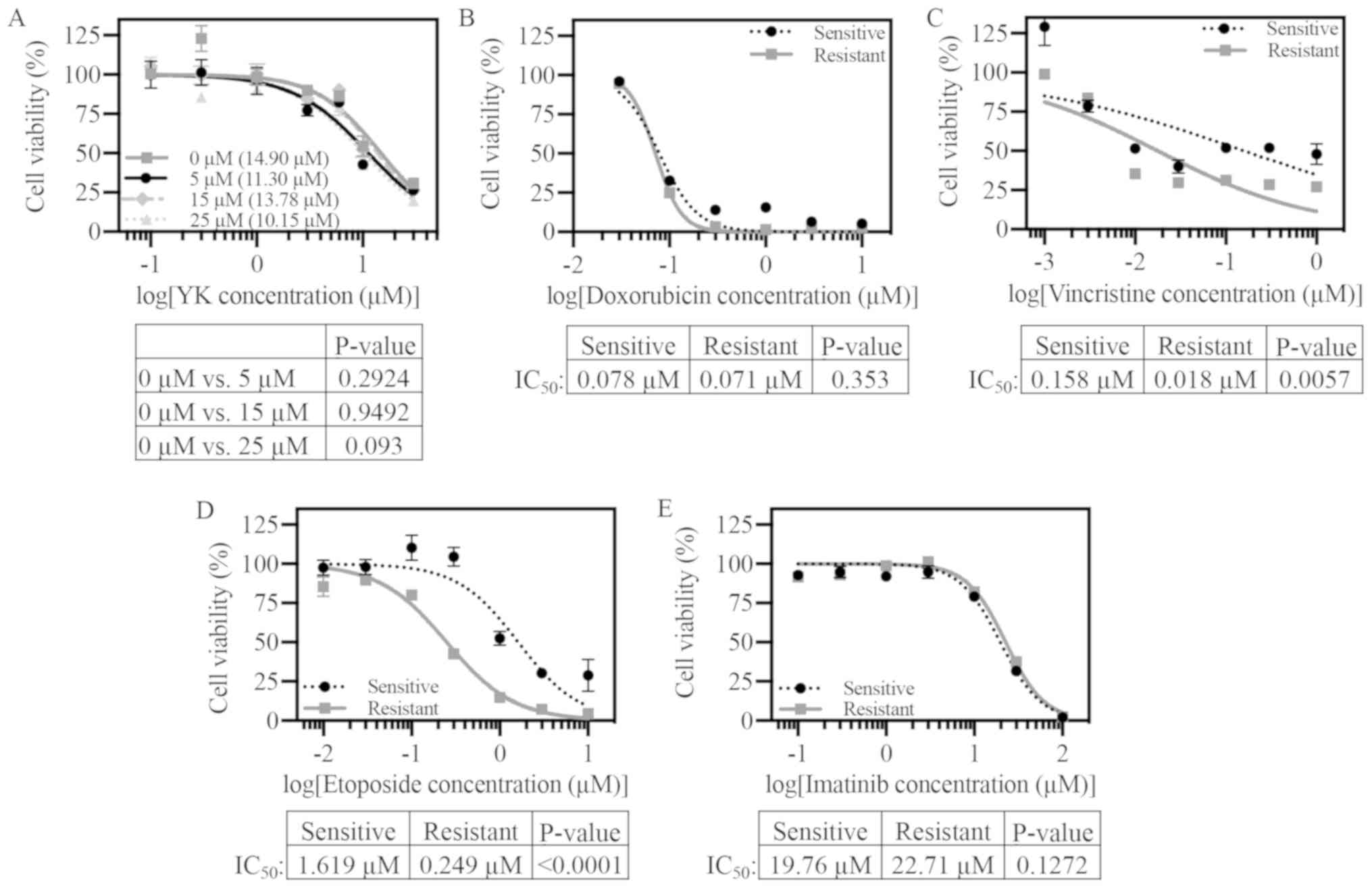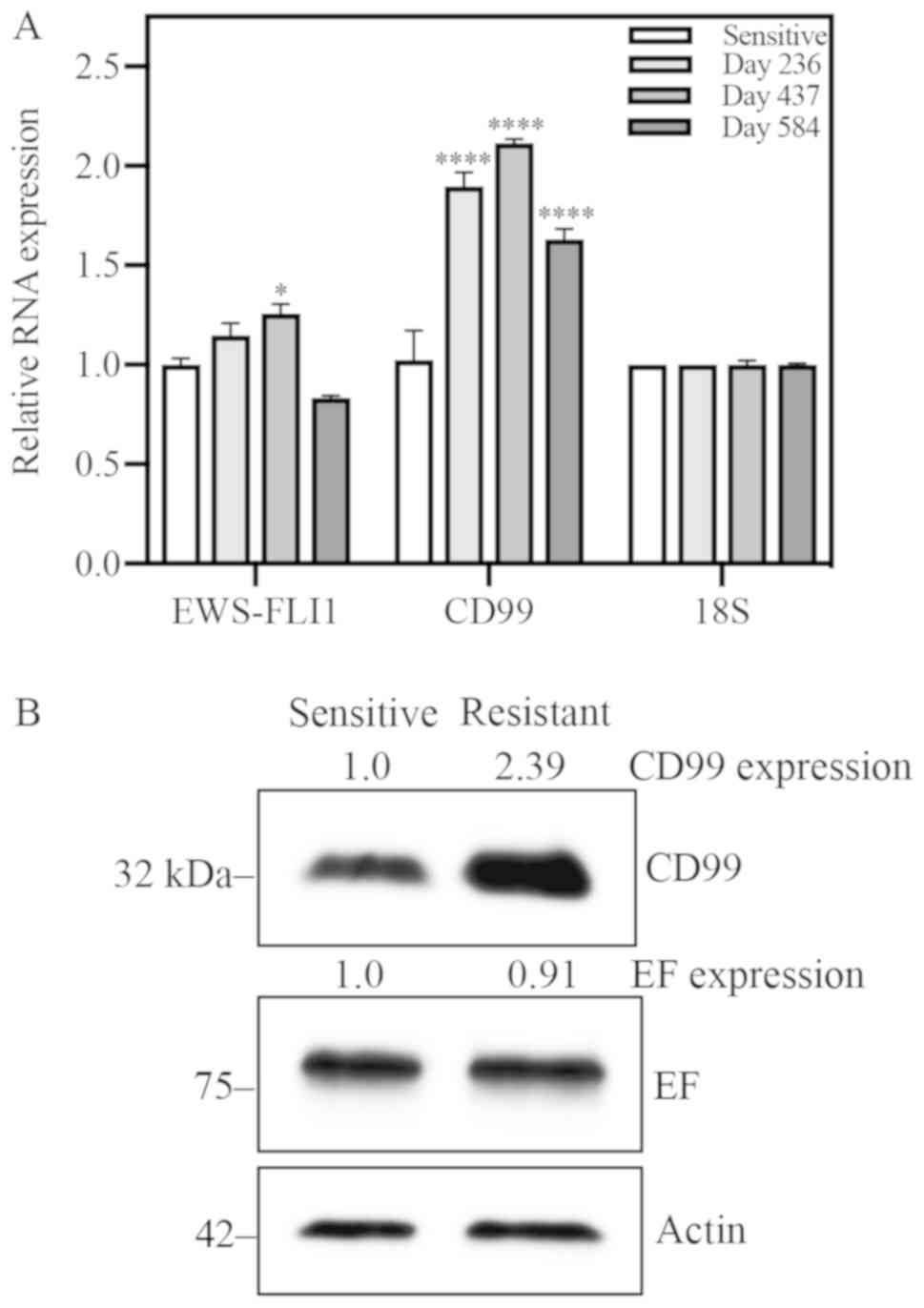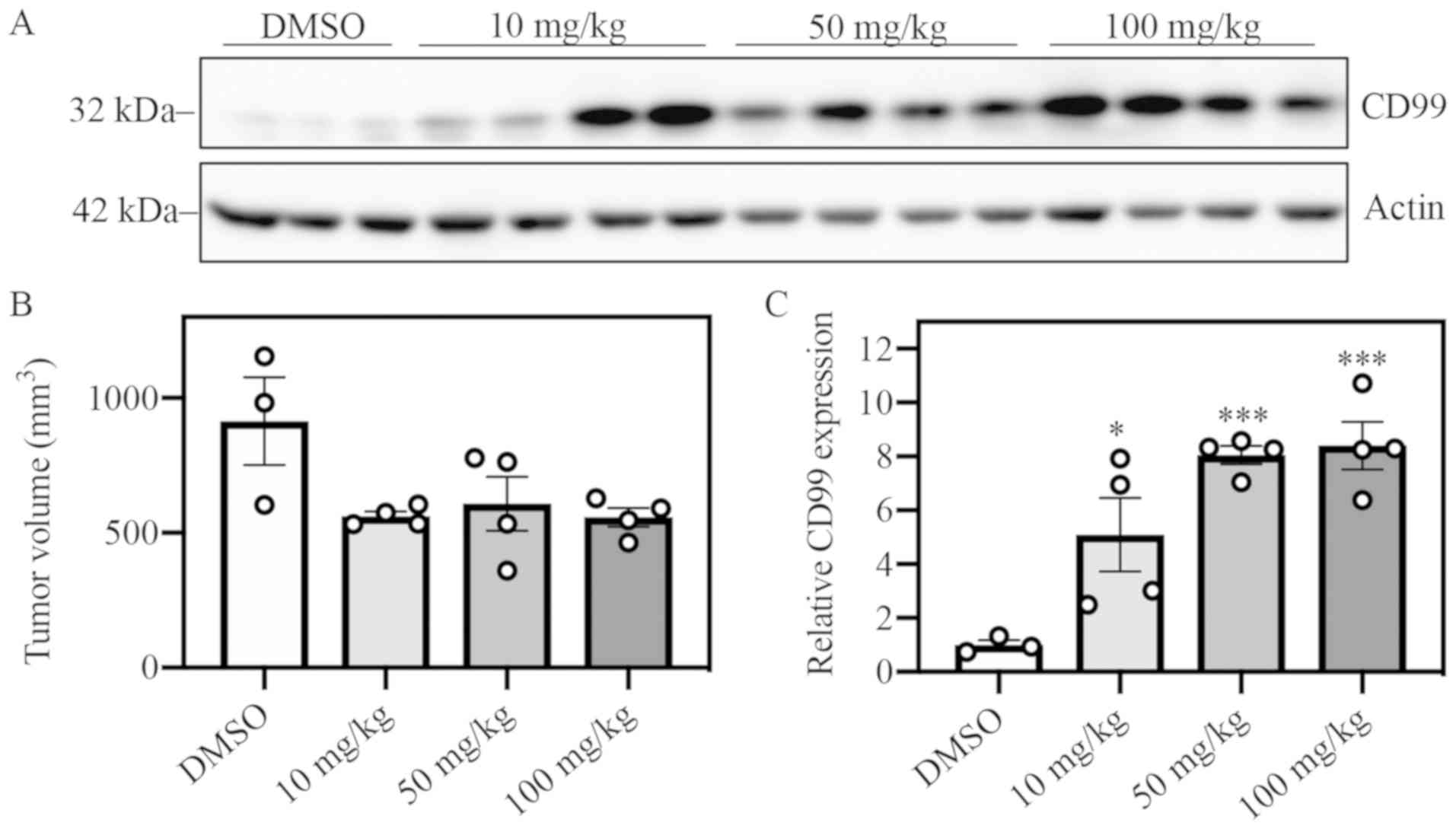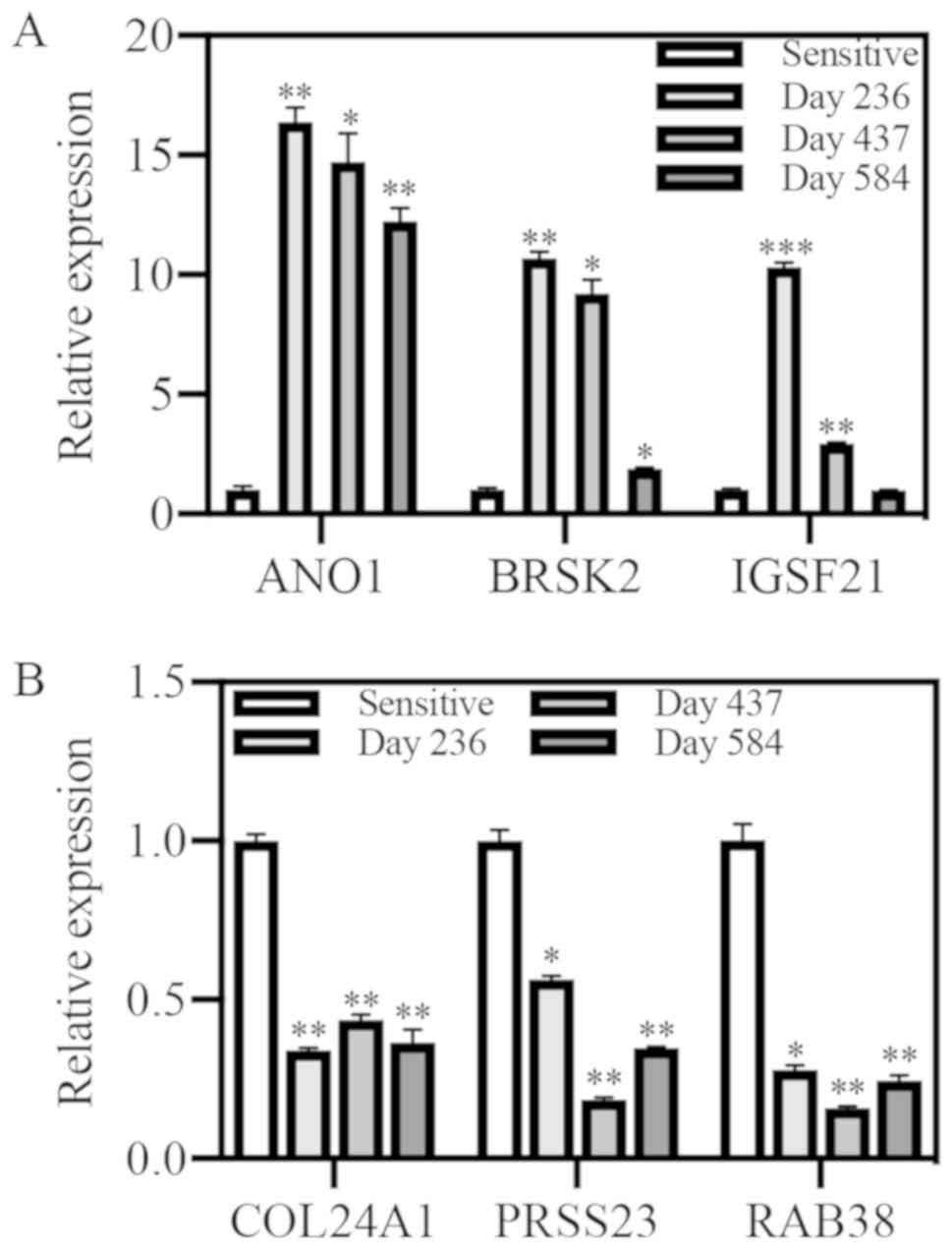|
1
|
Balamuth NJ and Womer RB: Ewing's sarcoma.
Lancet Oncol. 11:184–192. 2010. View Article : Google Scholar : PubMed/NCBI
|
|
2
|
Aurias A, Rimbaut C, Buffe D, Dubousset J
and Mazabraud A: Chromosomal translocations in Ewing's sarcoma. N
Engl J Med. 309:496–498. 1983. View Article : Google Scholar
|
|
3
|
Delattre O, Zucman J, Plougastel B,
Desmaze C, Melot T, Peter M, Kovar H, Joubert I, de Jong P, Rouleau
G, et al: Gene fusion with an ETS DNA-binding domain caused by
chromosome translocation in human tumours. Nature. 359:162–165.
1992. View
Article : Google Scholar : PubMed/NCBI
|
|
4
|
Delattre O, Zucman J, Melot T, Garau XS,
Zucker JM, Lenoir GM, Ambros PF, Sheer D, Turc-Carel C, Triche TJ,
et al: The Ewing family of tumors-a subgroup of small-round-cell
tumors defined by specific chimeric transcripts. N Engl J Med.
331:294–299. 1994. View Article : Google Scholar : PubMed/NCBI
|
|
5
|
May WA, Gishizky ML, Lessnick SL, Lunsford
LB, Lewis BC, Delattre O, Zucman J, Thomas G and Denny CT: Ewing
sarcoma 11;22 translocation produces a chimeric transcription
factor that requires the DNA-binding domain encoded by FLI1 for
transformation. Proc Natl Acad Sci USA. 90:5752–5756. 1993.
View Article : Google Scholar : PubMed/NCBI
|
|
6
|
Jaishankar S, Zhang J, Roussel MF and
Baker SJ: Transforming activity of EWS/FLI is not strictly
dependent upon DNA-binding activity. Oncogene. 18:5592–5597. 1999.
View Article : Google Scholar : PubMed/NCBI
|
|
7
|
Chan D, Wilson TJ, Xu D, Cowdery HE, Sanij
E, Hertzog PJ and Kola I: Transformation induced by Ewing's sarcoma
associated EWS/FLI-1 is suppressed by KRAB/FLI-1. Br J Cancer.
88:137–145. 2003. View Article : Google Scholar : PubMed/NCBI
|
|
8
|
May WA, Lessnick SL, Braun BS, Klemsz M,
Lewis BC, Lunsford LB, Hromas R and Denny CT: The Ewing's sarcoma
EWS/FLI-1 fusion gene encodes a more potent transcriptional
activator and is a more powerful transforming gene than FLI-1. Mol
Cell Biol. 13:7393–7398. 1993. View Article : Google Scholar : PubMed/NCBI
|
|
9
|
Ramakrishnan R, Fujimura Y, Zou JP, Liu F,
Lee L, Rao VN and Reddy ES: Role of protein-protein interactions in
the antiapoptotic function of EWS-Fli-1. Oncogene. 23:7087–7094.
2004. View Article : Google Scholar : PubMed/NCBI
|
|
10
|
Ohno T, Rao VN and Reddy ES: EWS/Fli-1
chimeric protein is a transcriptional activator. Cancer Res.
53:5859–5863. 1993.PubMed/NCBI
|
|
11
|
Toretsky JA, Erkizan V, Levenson A, Abaan
OD, Parvin JD, Cripe TP, Rice AM, Lee SB and Uren A: Oncoprotein
EWS-FLI1 activity is enhanced by RNA helicase A. Cancer Res.
66:5574–5581. 2006. View Article : Google Scholar : PubMed/NCBI
|
|
12
|
Erkizan HV, Schneider JA, Sajwan K, Graham
GT, Griffin B, Chasovskikh S, Youbi SE, Kallarakal A, Chruszcz M,
Padmanabhan R, et al: RNA helicase A activity is inhibited by
oncogenic transcription factor EWS-FLI1. Nucleic Acids Res.
43:1069–1080. 2015. View Article : Google Scholar : PubMed/NCBI
|
|
13
|
Yang L, Chansky HA and Hickstein DD:
EWS.Fli-1 fusion protein interacts with hyperphosphorylated RNA
polymerase II and interferes with serine-arginine protein-mediated
RNA splicing. J Biol Chem. 275:37612–37618. 2000. View Article : Google Scholar : PubMed/NCBI
|
|
14
|
Knoop LL and Baker SJ: The splicing factor
U1C represses EWS/FLI-mediated transactivation. J Biol Chem.
275:24865–24871. 2000. View Article : Google Scholar : PubMed/NCBI
|
|
15
|
Knoop LL and Baker SJ: EWS/FLI alters
5′-splice site selection. J Biol Chem. 276:22317–22322. 2001.
View Article : Google Scholar : PubMed/NCBI
|
|
16
|
Selvanathan SP, Graham GT, Erkizan HV,
Dirksen U, Natarajan TG, Dakic A, Yu S, Liu X, Paulsen MT, Ljungman
ME, et al: Oncogenic fusion protein EWS-FLI1 is a network hub that
regulates alternative splicing. Proc Natl Acad Sci USA.
112:E1307–E1316. 2015. View Article : Google Scholar : PubMed/NCBI
|
|
17
|
Sanchez G, Bittencourt D, Laud K, Barbier
J, Delattre O, Auboeuf D and Dutertre M: Alteration of cyclin D1
transcript elongation by a mutated transcription factor
up-regulates the oncogenic D1b splice isoform in cancer. Proc Natl
Acad Sci USA. 105:6004–6009. 2008. View Article : Google Scholar : PubMed/NCBI
|
|
18
|
Erkizan HV, Kong Y, Merchant M,
Schlottmann S, Barber-Rotenberg JS, Yuan L, Abaan OD, Chou TH,
Dakshanamurthy S, Brown ML, et al: A small molecule blocking
oncogenic protein EWS-FLI1 interaction with RNA helicase A inhibits
growth of Ewing's sarcoma. Nat Med. 15:750–756. 2009. View Article : Google Scholar : PubMed/NCBI
|
|
19
|
Barber-Rotenberg JS, Selvanathan SP, Kong
Y, Erkizan HV, Snyder TM, Hong SP, Kobs CL, South NL, Summer S,
Monroe PJ, et al: Single enantiomer of YK-4-279 demonstrates
specificity in targeting the oncogene EWS-FLI1. Oncotarget.
3:172–182. 2012. View Article : Google Scholar : PubMed/NCBI
|
|
20
|
Hong SH, Youbi SE, Hong SP, Kallakury B,
Monroe P, Erkizan HV, Barber-Rotenberg JS, Houghton P, Üren A and
Toretsky JA: Pharmacokinetic modeling optimizes inhibition of the
‘undruggable’ EWS-FLI1 transcription factor in Ewing sarcoma.
Oncotarget. 5:338–350. 2014. View Article : Google Scholar : PubMed/NCBI
|
|
21
|
Zöllner SK, Selvanathan SP, Graham GT,
Commins RMT, Hong SH, Moseley E, Parks S, Haladyna JN, Erkizan HV,
Dirksen U, et al: Inhibition of the oncogenic fusion protein
EWS-FLI1 causes G2-M cell cycle arrest and enhanced
vincristine sensitivity in Ewing's sarcoma. Sci Signal. 10(pii):
eaam84292017. View Article : Google Scholar : PubMed/NCBI
|
|
22
|
Rahim S, Beauchamp EM, Kong Y, Brown ML,
Toretsky JA and Üren A: YK-4-279 inhibits ERG and ETV1 mediated
prostate cancer cell invasion. PLoS One. 6:e193432011. View Article : Google Scholar : PubMed/NCBI
|
|
23
|
Rahim S, Minas T, Hong SH, Justvig S,
Çelik H, Kont YS, Han J, Kallarakal AT, Kong Y, Rudek MA, et al: A
small molecule inhibitor of ETV1, YK-4-279, prevents prostate
cancer growth and metastasis in a mouse Xenograft model. PLoS One.
9:e1142602014. View Article : Google Scholar : PubMed/NCBI
|
|
24
|
Winters B, Brown L, Coleman I, Nguyen H,
Minas TZ, Kollath L, Vasioukhin V, Nelson P, Corey E, Üren A and
Morrissey C: Inhibition of ERG activity in patient-derived prostate
cancer Xenografts by YK-4-279. Anticancer Res. 37:3385–3396.
2017.PubMed/NCBI
|
|
25
|
Sun W, Rojas Y, Wang H, Yu Y, Wang Y, Chen
Z, Rajapakshe K, Xu X, Huang W, Agarwal S, et al: EWS-FLI1 and RNA
helicase A interaction inhibitor YK-4-279 inhibits growth of
neuroblastoma. Oncotarget. 8:94780–94792. 2017. View Article : Google Scholar : PubMed/NCBI
|
|
26
|
Kollareddy M, Sherrard A, Park JH, Szemes
M, Gallacher K, Melegh Z, Oltean S, Michaelis M, Cinatl J Jr, Kaidi
A and Malik K: The small molecule inhibitor YK-4-279 disrupts
mitotic progression of neuroblastoma cells, overcomes drug
resistance and synergizes with inhibitors of mitosis. Cancer Lett.
403:74–85. 2017. View Article : Google Scholar : PubMed/NCBI
|
|
27
|
TK216 in patients with relapsed or
refractory Ewing sarcoma. NCT02657005. https://clinicaltrials.gov/ct2/show/NCT02657005January
15–2016
|
|
28
|
Livak KJ and Schmittgen TD: Analysis of
relative gene expression data using real-time quantitative PCR and
the 2(-Delta Delta C(T)) method. Methods. 25:402–408. 2001.
View Article : Google Scholar : PubMed/NCBI
|
|
29
|
Bolger AM, Lohse M and Usadel B:
Trimmomatic: A flexible trimmer for Illumina sequence data.
Bioinformatics. 30:2114–2120. 2014. View Article : Google Scholar : PubMed/NCBI
|
|
30
|
Dobin A, Davis CA, Schlesinger F, Drenkow
J, Zaleski C, Jha S, Batut P, Chaisson M and Gingeras TR: STAR:
Ultrafast universal RNA-seq aligner. Bioinformatics. 29:15–21.
2013. View Article : Google Scholar : PubMed/NCBI
|
|
31
|
Robinson MD, McCarthy DJ and Smyth GK:
EdgeR: A Bioconductor package for differential expression analysis
of digital gene expression data. Bioinformatics. 26:139–140. 2010.
View Article : Google Scholar : PubMed/NCBI
|
|
32
|
Lamhamedi-Cherradi SE, Menegaz BA,
Ramamoorthy V, Aiyer RA, Maywald RL, Buford AS, Doolittle DK,
Culotta KS, O'Dorisio JE and Ludwig JA: An oral formulation of
YK-4-279: Preclinical efficacy and acquired resistance patterns in
Ewing sarcoma. Mol Cancer Ther. 14:1591–1604. 2015. View Article : Google Scholar : PubMed/NCBI
|
|
33
|
McDermott M, Eustace AJ, Busschots S,
Breen L, Crown J, Clynes M, O'Donovan N and Stordal B: In vitro
development of chemotherapy and targeted therapy drug-resistant
cancer cell lines: A practical guide with case studies. Front
Oncol. 4:402014. View Article : Google Scholar : PubMed/NCBI
|
|
34
|
Foo J and Michor F: Evolution of acquired
resistance to anti-cancer therapy. J Theor Biol. 355:10–20. 2014.
View Article : Google Scholar : PubMed/NCBI
|
|
35
|
Rocchi A, Manara MC, Sciandra M, Zambelli
D, Nardi F, Nicoletti G, Garofalo C, Meschini S, Astolfi A, Colombo
MP, et al: CD99 inhibits neural differentiation of human Ewing
sarcoma cells and thereby contributes to oncogenesis. J Clin
Invest. 120:668–680. 2010. View Article : Google Scholar : PubMed/NCBI
|
|
36
|
Lessnick SL, Dacwag CS and Golub TR: The
Ewing's sarcoma oncoprotein EWS/FLI induces a p53-dependent growth
arrest in primary human fibroblasts. Cancer Cell. 1:393–401. 2002.
View Article : Google Scholar : PubMed/NCBI
|
|
37
|
Hu-Lieskovan S, Zhang J, Wu L, Shimada H,
Schofield DE and Triche TJ: EWS-FLI1 fusion protein up-regulates
critical genes in neural crest development and is responsible for
the observed phenotype of Ewing's family of tumors. Cancer Res.
65:4633–4644. 2005. View Article : Google Scholar : PubMed/NCBI
|
|
38
|
Suvà ML, Riggi N, Stehle JC, Baumer K,
Tercier S, Joseph JM, Suvà D, Clément V, Provero P, Cironi L, et
al: Identification of cancer stem cells in Ewing's sarcoma. Cancer
Res. 69:1776–1781. 2009. View Article : Google Scholar : PubMed/NCBI
|
|
39
|
Aldeghaither DS, Zahavi DJ, Murray JC,
Fertig EJ, Graham GT, Zhang YW, O'Connell A, Ma J, Jablonski SA and
Weiner LM: A mechanism of resistance to antibody-targeted immune
attack. Cancer Immunol Res. 7:230–243. 2019. View Article : Google Scholar : PubMed/NCBI
|
|
40
|
Tuveson DA, Willis NA, Jacks T, Griffin
JD, Singer S, Fletcher CD, Fletcher JA and Demetri GD: STI571
inactivation of the gastrointestinal stromal tumor c-KIT
oncoprotein: Biological and clinical implications. Oncogene.
20:5054–5058. 2001. View Article : Google Scholar : PubMed/NCBI
|
|
41
|
Berglund E, Akcakaya P, Berglund D,
Karlsson F, Vukojević V, Lee L, Bogdanović D, Lui WO, Larsson C,
Zedenius J, et al: Functional role of the Ca2+-activated
Cl− channel DOG1/TMEM16A in gastrointestinal stromal
tumor cells. Exp Cell Res. 326:315–325. 2014. View Article : Google Scholar : PubMed/NCBI
|
|
42
|
Rizzo FM, Palmirotta R, Marzullo A, Resta
N, Cives M, Tucci M and Silvestris F: Parallelism of DOG1
expression with recurrence risk in gastrointestinal stromal tumors
bearing KIT or PDGFRA mutations. BMC Cancer. 16:872016. View Article : Google Scholar : PubMed/NCBI
|
|
43
|
Simon S, Grabellus F, Ferrera L, Galietta
L, Schwindenhammer B, Mühlenberg T, Taeger G, Eilers G, Treckmann
J, Breitenbuecher F, et al: DOG1 regulates growth and IGFBP-5 in
gastrointestinal stromal tumors. Cancer Res. 73:3661–3670. 2013.
View Article : Google Scholar : PubMed/NCBI
|
|
44
|
Kreppel M, Aryee DN, Schaefer KL, Amann G,
Kofler R, Poremba C and Kovar H: Suppression of KCMF1 by
constitutive high CD99 expression is involved in the migratory
ability of Ewing's sarcoma cells. Oncogene. 25:2795–2800. 2006.
View Article : Google Scholar : PubMed/NCBI
|















